Firstly it should be noted that of all school teachers none do I respect more than those that work day in and day out with the children of Early Years that I call simply the ‘little people.’
As one experienced EYFS teacher once told me……
‘they are a straight forward crowd – if they don’t like what you are doing they will wander off and play something they make up themselves’
Early years PE can be both extremely challenging and unbelievably rewarding – often at the same time. What is true is that it takes careful planning, constant adaptation and repeated modelling.
Until fairly recently in my career I had managed to avoid the ‘little people’ mainly through fear and a little bit of luck. The truth is I had always feared that they would vote with their feet and leave me high and dry. Having now overcome my fear of the EYFS Children I would now like to share a few ideas that have worked for me– obviously you will have to modify, adapt and change to suit the children that you work with but I hope the ideas are of use.
Lesson Priorities;
I guess the first thing to consider is routines for PE; this is hugely important so that you maximise your time – small things like students getting changed, what they do when they enter the hall, cues for listening and freezing, taking it in turns, making lines and so forth.
The focus for lessons are simple but crucial building blocks for their PE;
- Space orientation
- Body control
- Recalling and copying
- Patterns
After some trial and error with the ‘little people’ I quickly realised that the use of imagery and story created a more play like environment. This allows the children to immerse themselves and give an environment in which we can practice and introduce those crucial PE building blocks. I also realised/recognised that you must involve yourself in that story – give yourself a role and be prepared to model actions and instructions and be an active part of the story that you create.
The lesson ideas below are exactly that; ideas – and can be used to support previous PE work or used as a whole lesson. All the sessions below do require some prep work; check that students know the animals, that they know or can impersonate how they move, and that they recognise simple movements such as hopping and jumping. To double check use simple warm ups using examples before moving on to the main content.
Five Lesson Ideas;
Getting the children to understand boundaries and use of space is always my first port of call. Children in EYFS rarely understand boundary markers and often escape from the activities so getting them to recognise what they should do when they reach one of your boundaries is crucial.
The Driving Lesson
Lesson Focus; Space Orientation
With this is in mind I designed a ‘Driving lesson.’ In the driving lesson each child is handed a coloured Coyt as a steering wheel and are asked to take a lesson with you. Their aim is to see if they can pass their driving test by the end of the session.
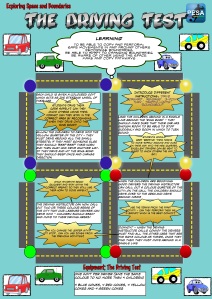
Here is a basic run down of how the lesson could look;
- Set up a four grid area, hand each child a coloured coyt (don’t forget to save one for yourself!)
- Drive the children around the ring road (Outside line of four grid area), when they are comfortable with the route occasionally change direction by saying ‘three point turn’ or say ‘brake’ to stop.
- Allow children to drive around inside the four grids (start at walking pace); but every time they reach the ring road they must beep their horn and turn round, likewise if they meet another driver they must do a double beep of their horn and change direction
- When the children are moving well shout ‘brake’ and tell them that now they are only allowed inside two of the four grids; drive them around the outside of the new area; then let them into the new smaller area one at a time – same rules as before – double beep and direction change when they meet another driver and a single beep and direction change if they meet the ring road.
- When children are moving well and keeping good spaces shout ‘brake’ – now students are only allowed in one grid – drive them around the outside and then let them in – can they still use their horns to help them drive safely??
- When you split the grid into four if you use four different colours you can then call out the different zones that they are allowed in; go from one – to two – to three – to all four. Then reverse until you are down to one zone.
- At the start you handed out coloured coyts – you can also do a convey version of the above activity
The idea of the horns is to get children to recognise barriers and obstacles and then to react to it; so when they beep they must change direction.
The session can be downloaded here in PDF form driving-lesson-pdf
To build upon our space orientation using pathways is another way of getting children to recognise and react to different boundaries and space. Another crucial building block for PE and Sport is that of patterns and linking things together – the lesson below begins to introduce this;
The Jungle Pathfinder
Lesson Focus; space orientation and patterns
In this session you are leading a group of children on a Jungle trek; their job is to find safe routes on which they can travel safely through the jungle. They are the ‘Pathfinders’ and must make their own path. Each child is placed in a small team such as the Green tea, Red Team and so forth.
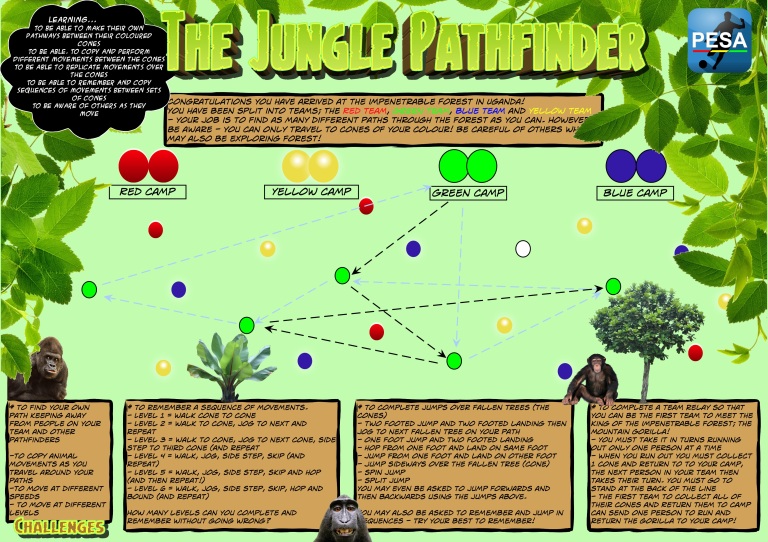
Here is a basic run down of the session;
- From their team base children must head out and explore the jungle; if they are in the Green team they are only allowed to follow green cones, if they are on the red team they follow red cones and so on.
- Students must follow the imaginary lines between their coloured cones. Get them to make up their own route – they should not follow anyone else – even the people in their own teams. When you shout ‘Trees’ the pathfinders must continue along their path until they come to a ‘tree’ (a cone!) when they reach the tree they should stop. _ use this time to check that children have stuck to their correct colours!
- Underneath each tree, you should hide a picture of an animal – explain to the pathfinders that they will need to look under each tree and see what animal is hiding – then they must move to the next tree in the same way that the animal would. (They do not pick the animals up!)
- Ask children to return to their base camp and introduce and inform them that the very best expert pathfinders have excellent memories. This time they will be asked to remember different movements that they must perform. Start with one movement as they travel tree to tree such as walking, then introduce a second movement so that they walk to one tree and jog to the next and repeat the sequence. Gradually build it up – some children could remember up to five which was amazing to watch.
- Return them to base camp and explain to them that the reason that they have been practising making paths was to see whether which team could find the king of the Impenetrable Forest; The Mountain Gorilla (Hide his picture under a white cone!)

- In this relay race only one person from your team can run out at one time. When it is your turn you run out and pick up one cone and return it to your base camp. Then you go to the back of the line. Make the children aware that other pathfinders will also be racing around the jungle and should slow down or speed up if they see them crossing their path!
- The first team to collect all their colour cones can then run out to pick up the white cone – and find underneath – the Mountain Gorilla!
This will also mean that the students have also tidied up for you as well – which is a nice bonus!
To download the pdf version please click here; jungle-pathfinder-pdf
Once the children begin to appreciate and understand boundaries, working areas, space orientation and have begun to recognise patterns the following game works on memory and their observation skills; and at this age watching others is a crucial skill. In this game, good watching gives away clues which the children can use to solve the problem. To say they are quite happy when they find a matching pair is a bit of an understatement! This game is also a good activity for older students too.
Animal Pairs
Lesson Focus; Copying and remembering, patterns
In this game the animals have escaped from the local zoo and the children are asked if they could help to find them! They work in small teams and run out to the grid and are allowed to turn over just two cones; if they find the same animal under both they can pick both cones up and take them back. If the animals don’t match they must place the cones back on top and run back to their team allowing the next person to have their go!
In this game set up a six by six cone grid (adjust the space between each cone depending on group/area used) and split students into four teams.
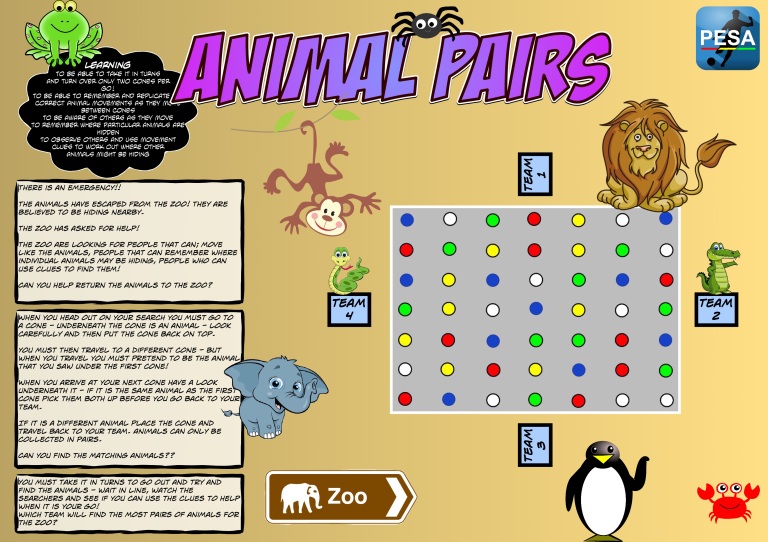
Similarly, you can do this with basic movements and turn it into a fitness activity. The set up and rules are the same and would make a good follow up to the session above.
Fitness Pairs
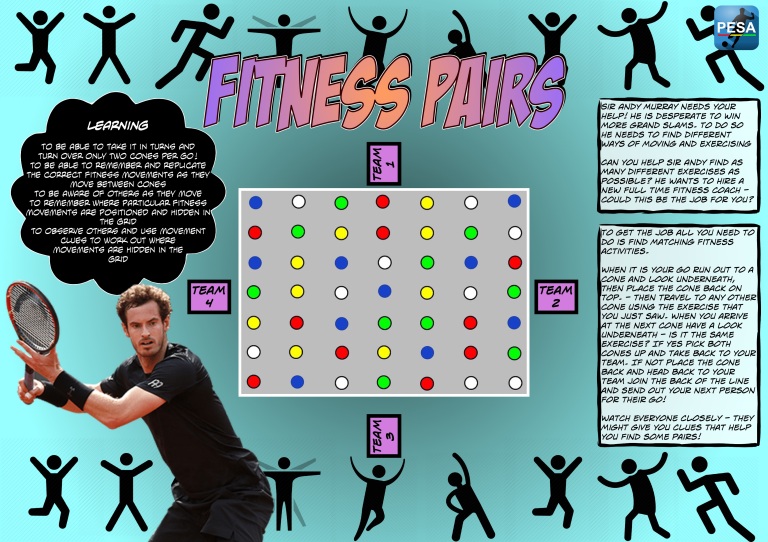
PDF Animal Pairs; animal-pairs
PDF Fitness Pairs; fitness-pairs-pdf
Supporting Resources;
PDF versions available here;
Another crucial building block is body control and developing core strength; the session below builds upon previous movements but also looks at being able to move slowly and hold shapes completely still within a Quest situation!
The Island
Lesson Focus; Body control, copying and replicating
In this session children go on an adventure to a secret tropical island! You (The teacher) are the captain of the ship and the children are the crew of your ship. The aim of the lesson is to explore the secret island; but be aware that something is lurking and living on the island!
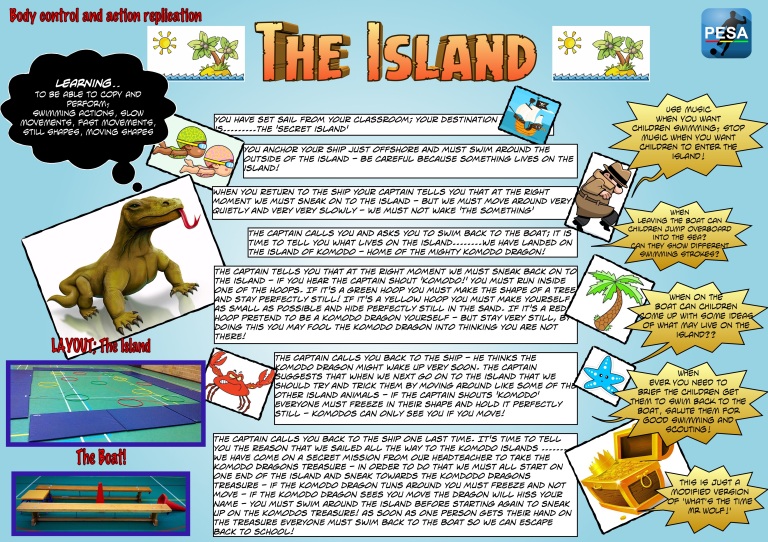
Basic lesson breakdown;
- Ask children to ‘scout’ the island by jumping off the boat and swimming around the outside of the island – how many different strokes can the children remember, can they tread water? Call them back to the boat.
- This time at the right moment children must sneak on to the island; but they must move very slowly and very quietly so they do not wake up the ‘something’ that is living on the island.
- The captain briefs the crew again on the boat; if when sneaking around on the island you hear the captain shout ‘Komodo’ the Children must run into a hoop and hold themselves completely still until it is safe to sneak around again!
- The Captain informs the children that the island that they are exploring is actually the island of Komodo; the home of the famous Komodo Dragon!
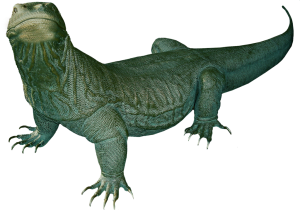
- To fool the Komodo dragon next time the children sneak on to the island they must move around like other island animals
- The final challenge for the children is to try and collect the treasure from the island so that they can take it back to school. The big problem being that the Komodo dragon is guarding it! – Basically, a version of ‘what’s the time Mr Wolf’ – When the Komodo Dragon turns around Children must freeze and hold their shape – if any children are seen moving their name is called and they must quickly go and swim a complete length around the island before returning to game.
To download a pdf version please click here; the-island-pdf
In Summary
When working with children of EYFS I have found that creating story scenarios helps keep them engaged in the activity for longer and allows practice of the crucial building blocks of PE. Modelling and adaptation is key but so is involving yourself in the story.
I hope the resources are of use (they took bloomin’ ages to put together!), I would love to hear any feedback if you give them a go – good luck!
By Kevin Peake
Founder of PESA; The PE and Sports Assessment Tool





One thought on “Five ideas for Early Years PE”